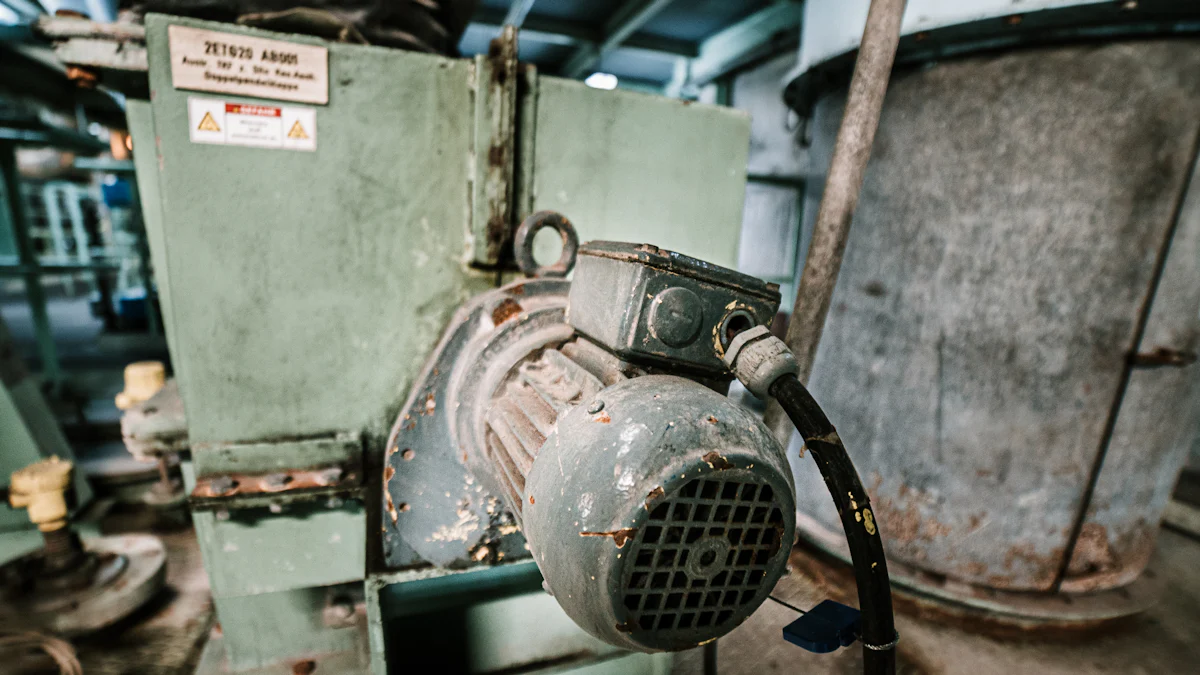Steel’s magnetism intrigues many due to its varied nature, leading to the question: is steel magnetic? The presence of iron in steel plays a crucial role in its magnetic properties. Iron, being ferromagnetic, imparts magnetism to steel. However, not all steel types exhibit the same magnetic behavior. For instance, stainless steel’s magnetism depends on its crystalline structure and composition. While austenitic stainless steel often remains non-magnetic, martensitic and ferritic types can be magnetic. Understanding these differences helps in selecting the right steel for specific applications, ensuring optimal performance and functionality.
Understanding Steel Composition

Steel’s magnetism often sparks curiosity, especially when considering its composition. I find that understanding the role of iron and other elements in steel is crucial to answering the question: is steel magnetic?
The Role of Iron
Iron serves as the backbone of steel’s magnetic properties. As a ferromagnetic material, iron naturally attracts magnets. When I examine steel, I notice that its iron content largely dictates its magnetic behavior. For instance, carbon steel, which contains a significant amount of iron, consistently exhibits magnetic properties. This characteristic makes it ideal for various industrial applications where magnetism is essential.
Influence of Other Elements
While iron is pivotal, other elements also influence steel’s magnetism. I have observed that alloying elements like silicon and aluminum can alter steel’s magnetic characteristics. According to a study published in IEEE, these elements can enhance or diminish the magnetic properties of electrical steels, depending on their concentration.
The presence of nickel in stainless steel often results in non-magnetic behavior, particularly in austenitic grades. However, martensitic and ferritic stainless steels, which lack nickel, tend to be magnetic. As highlighted in ongoing research in material science, the crystal structure and chemical composition of these steels determine their magnetic behavior.
Understanding these nuances helps me appreciate the complexity of steel’s magnetism. By considering both the iron content and the influence of other elements, I can better select the appropriate type of steel for specific applications, ensuring optimal performance and functionality.
Types of Stainless Steel and Their Magnetism
When I explore the world of stainless steel, I find that its magnetism varies significantly based on its type. Understanding these differences helps me make informed decisions when selecting materials for specific applications.
Austenitic Stainless Steel
Austenitic stainless steel stands out due to its non-magnetic nature. This type of steel, which includes grades like 304 and 316, owes its lack of magnetism to its austenitic crystal structure. The presence of nickel in these steels stabilizes the austenitic phase, making them generally non-magnetic. However, I have noticed that cold working can induce some magnetic properties in austenitic stainless steel. Despite this, its primary appeal lies in its corrosion resistance and formability, making it ideal for kitchen appliances and chemical equipment.
Ferritic Stainless Steel
In contrast, ferritic stainless steel exhibits magnetic properties. This type of steel contains a high concentration of iron, which contributes to its magnetism. Ferritic stainless steels, such as those used in automotive exhaust systems, offer good corrosion resistance and are less expensive than austenitic grades. I appreciate their magnetic nature, which makes them suitable for applications where magnetism is required, such as in certain electrical components.
Martensitic Stainless Steel
Martensitic stainless steel also displays magnetic characteristics. Unlike austenitic types, martensitic steels can be hardened through heat treatment, enhancing their strength and wear resistance. I find these steels particularly useful in applications requiring both magnetism and high strength, such as in cutlery and surgical instruments. The ability to harden martensitic stainless steel makes it versatile, though it typically offers less corrosion resistance compared to austenitic and ferritic types.
Understanding the magnetism of different stainless steel types allows me to choose the right material for each application. Whether I need non-magnetic properties for aesthetic purposes or magnetic characteristics for functional applications, knowing the distinctions between austenitic, ferritic, and martensitic stainless steels proves invaluable.
Practical Tests for Magnetism

When I want to determine if steel is magnetic, I often rely on practical tests. These tests help me understand the magnetic properties of different steel types, ensuring I choose the right material for my needs.
Simple Magnet Test
The simplest method I use involves a standard magnet. By bringing a magnet close to the steel, I can quickly assess its magnetic nature. If the steel attracts the magnet, it likely contains a significant amount of iron, making it ferromagnetic. This test proves especially useful for distinguishing between types of stainless steel. For instance, if the stainless steel is magnetic, it is probably ferritic or martensitic. On the other hand, if it does not attract the magnet, it might be austenitic. However, I remain cautious, as cold working can induce slight magnetism in austenitic stainless steels, which might lead to misleading results.
Importance of Magnetism in Applications
Understanding whether steel is magnetic holds great importance in various applications. In my experience, magnetism plays a crucial role in industries like construction, automotive, and electronics. For example, in the construction industry, magnetic steel can be essential for creating secure connections in structures. In the automotive sector, magnetic properties help in manufacturing components that require precise alignment and stability. Moreover, in electronics, magnetic steel is vital for producing transformers and inductors, where magnetic fields are necessary for functionality.
By conducting these practical tests, I gain valuable insights into the magnetic properties of steel. This knowledge allows me to make informed decisions, ensuring that I select the appropriate steel type for each application. Whether I need magnetic steel for structural integrity or non-magnetic steel for aesthetic purposes, understanding the magnetism of steel proves indispensable.
In exploring the question, “Is steel magnetic?” I have discovered that steel’s magnetism hinges on its composition, microstructure, and processing. The presence of iron and the crystal structure significantly influence whether steel exhibits magnetic properties. For instance, ferritic and martensitic stainless steels generally display magnetism due to their atomic arrangement and iron content. In contrast, austenitic stainless steels typically remain non-magnetic unless mechanical processes alter their internal structure. Understanding these factors is crucial for selecting the right steel for various applications, ensuring both functionality and performance.
FAQ
Is stainless steel magnetic?
Stainless steel can exhibit magnetic properties under certain conditions. I have found that austenitic stainless steel, in its annealed state, is typically non-magnetic. However, mechanical processes, such as cold working, can alter its internal structure, making it magnetic. On the other hand, martensitic and ferritic stainless steels naturally possess magnetic properties due to their crystal structures.
Why does some stainless steel not attract magnets?
The lack of magnetism in some stainless steel types, like austenitic grades, stems from their crystal structure. The presence of nickel stabilizes the austenitic phase, which does not support magnetism. This structural arrangement prevents the alignment of magnetic domains, resulting in non-magnetic behavior.
Can the magnetism of steel change over time?
Yes, the magnetism of steel can change over time, especially if it undergoes mechanical or thermal processes. For instance, cold working can induce magnetism in austenitic stainless steel. Similarly, heat treatment can alter the magnetic properties of martensitic stainless steel, enhancing its strength and wear resistance.
How can I test if steel is magnetic?
I often use a simple magnet test to determine if steel is magnetic. By bringing a magnet close to the steel, I can quickly assess its magnetic nature. If the steel attracts the magnet, it likely contains a significant amount of iron, making it ferromagnetic. This test helps distinguish between different types of stainless steel.
What role does iron play in steel’s magnetism?
Iron serves as the backbone of steel’s magnetic properties. As a ferromagnetic material, iron naturally attracts magnets. In steel, the iron content largely dictates its magnetic behavior. For example, carbon steel, with its high iron content, consistently exhibits magnetic properties, making it suitable for various industrial applications.
Are all types of steel magnetic?
Not all types of steel are magnetic. While most carbon steels are magnetic due to their iron content, stainless steels vary. Austenitic stainless steels are generally non-magnetic, whereas ferritic and martensitic types can be magnetic. The specific alloying elements and crystal structures determine the magnetic properties of each steel type.
Does the presence of nickel affect steel’s magnetism?
Yes, the presence of nickel significantly affects steel’s magnetism. In austenitic stainless steels, nickel stabilizes the austenitic phase, resulting in non-magnetic behavior. This element alters the crystal structure, preventing the alignment of magnetic domains and thus reducing magnetism.
Why is understanding steel’s magnetism important?
Understanding steel’s magnetism is crucial for selecting the right material for specific applications. In industries like construction, automotive, and electronics, magnetism plays a vital role. For example, magnetic steel ensures secure connections in structures, precise alignment in automotive components, and functionality in electronic devices.
Can processing methods influence steel’s magnetism?
Processing methods can indeed influence steel’s magnetism. Mechanical processes, such as cold working, can induce magnetism in non-magnetic steels like austenitic stainless steel. Heat treatment can also modify the magnetic properties of martensitic stainless steel, affecting its strength and wear resistance.
How does the crystal structure affect steel’s magnetism?
The crystal structure significantly impacts steel’s magnetism. In austenitic stainless steels, the austenitic phase, stabilized by nickel, results in non-magnetic behavior. Conversely, ferritic and martensitic stainless steels have crystal structures that support magnetism, allowing the alignment of magnetic domains. Understanding these structural differences helps in selecting the appropriate steel for various applications.
